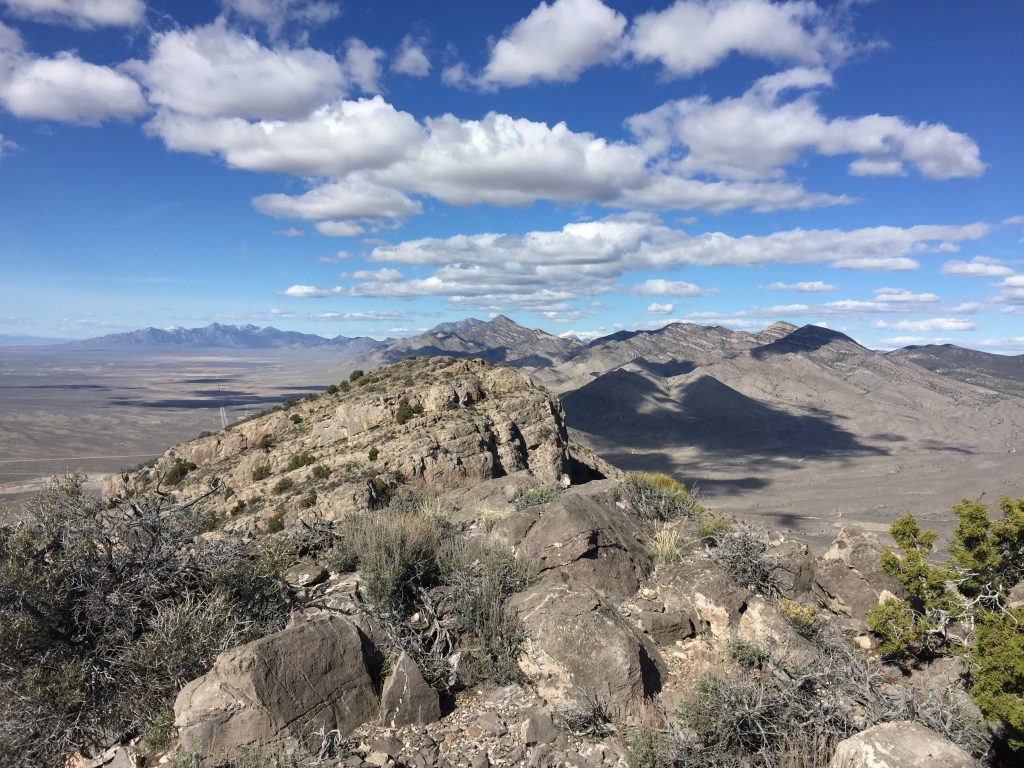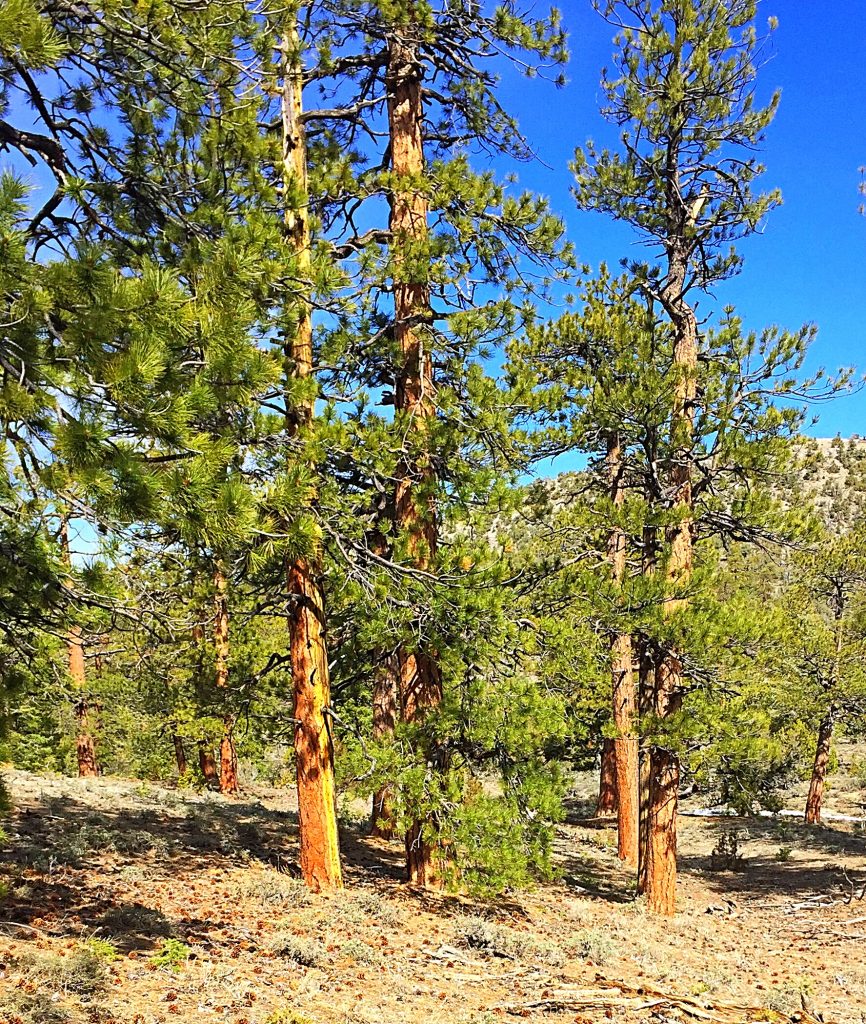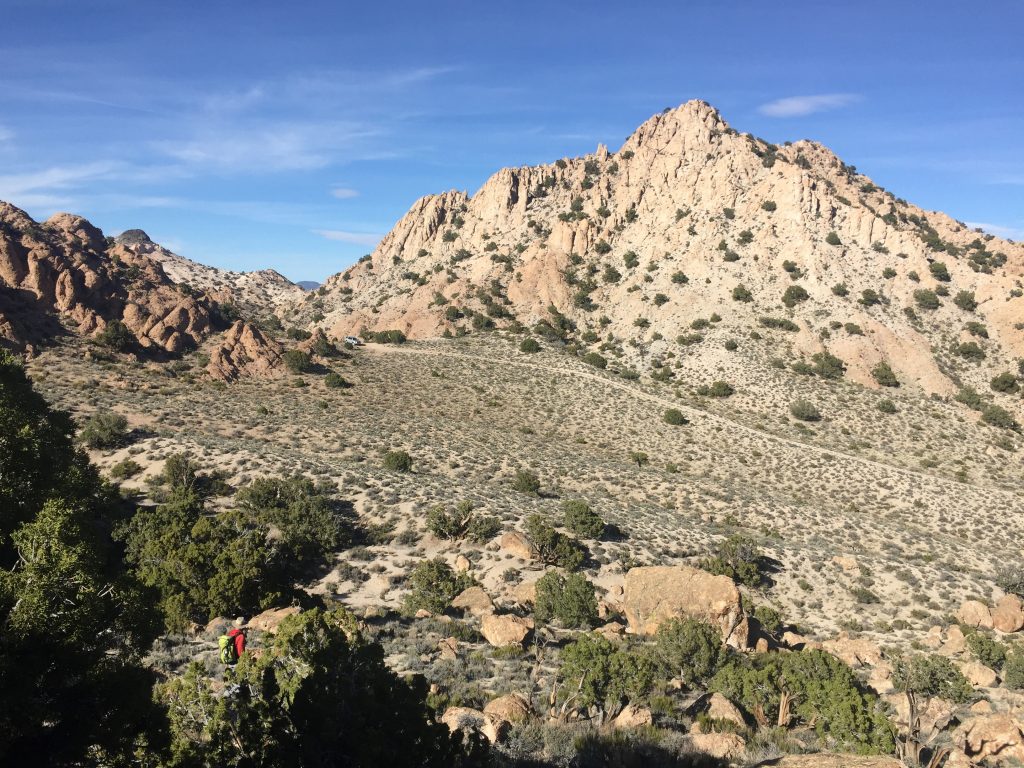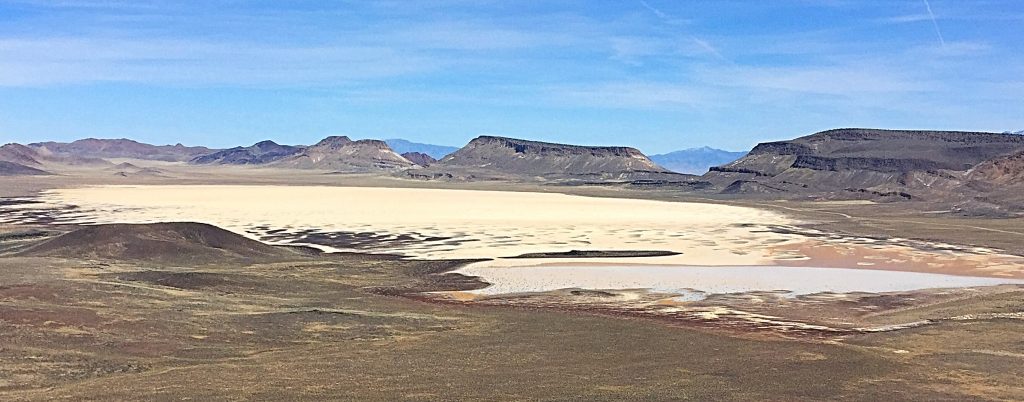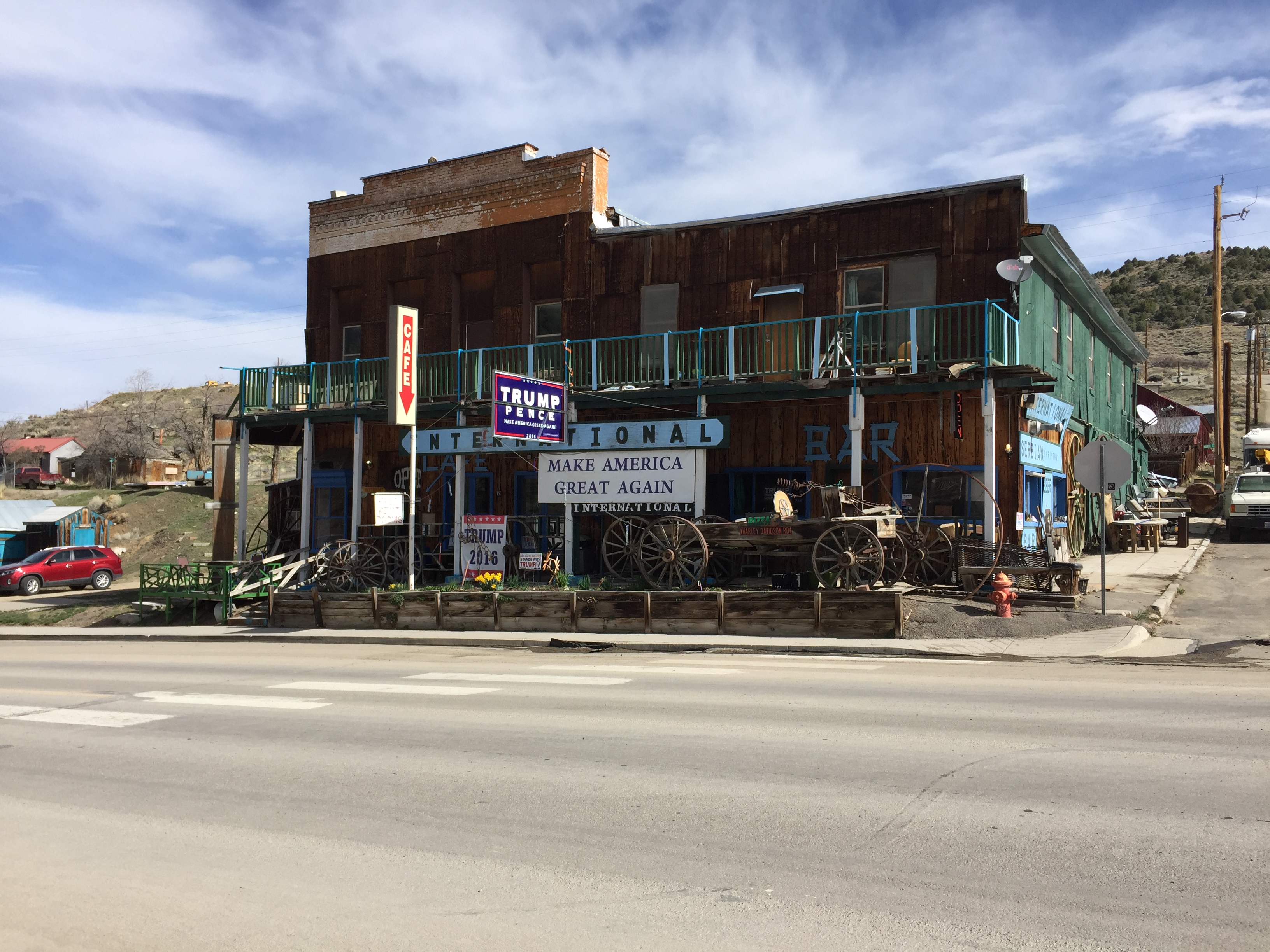April 1-6, 2017
For the previous 2 years, John Platt and I fled the Idaho Winter in February in an effort to satisfy our peakbagging addiction by spending a week climbing in Death Valley and Southern Nevada. While we planned to undertake a 3rd trip in 2017, the ferocious Winter brought significant snow to those normally snow-free areas and we decided to postpone our trip until April 1st. Since we had a later departure time, we planned to visit areas that are usually too cold and snowy in February. On April 1st, we departed a rainy Idaho for South Central Nevada, looking forward to exploring new areas and peaks.
I have had a long love affair with Nevada. My first road trip through Nevada was in 1974 when I was on my way to Sequoia and Kings Canyon National Parks for a job with the National Park Service. I saw enough during that long drive to develop a long-term fascination with the impressive landscape. Ever since, I have always considered Nevada to be the “Mountain Kingdom.” The state has a physical and cultural ambiance unlike anywhere else.
Nevada has over 140 different mountain ranges interspersed by wide, dry valleys. Despite having driven all of the major highways, tackled many back roads and climbed 90 of its mountains, I have barely scratched the surface. I keep trying to consume this elephant a bite at a time. Our first destination was a mountainous area south of Lund, Nevada which has peaks located on either side of NV-318 with decent access.
Saturday, April 1st. It was a long drive from Boise to our first objective, Gap Mountain. The terrain in Southern Idaho and Northern Nevada was wet and muddy. After we passed Ely, Nevada, the skies cleared and the ground was drier. The area around Gap Mountain was dry. We found a good 2-track road that took us to the base of this complex peak with 3 summits. We parked near the base of the South Ridge around 3:30PM. Our climb started by traversing north and upward across the East Face until we reached a gully that dropped down from the saddle between the [lower] South Summit and the True Summit. We took a steeper route up to the saddle and followed the summit ridge to the top. We found a Sierra Club register on top.
After the climb, we found a campsite at the base of Peak 6449 and Peak 6446. The view from camp was massive and included busy NV-318 a few miles away. We occasionally heard the trucks and motorhomes driving by but, for the most part, enjoyed the tranquility of our first evening out.
Sunday, April 2nd. My primary goal today was to climb Burnt Peak which was located to the south. However, before driving to Burnt Peak, we had unfinished business at our current location. Peak 6446 was north of our camp but the map I had printed out was of poor quality and we were not able to determine which point along the ridge was the actual summit. We had studied the ridge from Gap Mountain the day before and identified 2 candidates. One looked easy but the other looked like a rock dome that would present climbing difficulties.
We climbed up the ridge northeast of camp to the first potential high point. Once on top, it was evident that the rocky dome was the high point. From our vantage point, the dome looked to be a technical problem. So we followed the winding ridge north toward the dome hoping that we could find a route on its West Side. The ridge walk was easy and we soon found ourselves walking under the cliffs traversing toward the west. We found a gully that looked promising and climbed it. After 30 feet, we found a sloping, slab-covered face that was easy to climb to the summit.
We returned to camp, packed up the 4Runner and moved on to Peak 6449 which turned out to be a quick hike. Time to move on.

Peak 6449 as viewed from the south. We found a route through the cliffs on the peak’s West Side which is around the left-hand side of this photo.
I first spotted Burnt Peak during a drive between Boise and Las Vegas 6-7 years ago. The distinctive reddish-colored peak looked like a volcanic cone. I set my sights on climbing the peak. It was now time. The peak sits in the center of a group of sage- and juniper-covered peaks several miles east of NV-378. On the map, the driving approach looked straightforward. However, our printed map did not jive with the roads shown on John’s GPS. Between the 2 resources and a bit of dead reckoning, we arrived within striking distance of the summit on the peak’s West Side.

Burnt Peak is the cone-shaped point rising over the truck and the horizon. At this juncture, we are trying to decide whether to go straight or take the left fork.
After a snack, we headed for the summit by ascending a line that kept us out of the loose talus as much as possible. This route was Class 2 but steep. After gaining 1,200 vertical feet, we arrived on the summit and found a large cairn but no register.

A weathered juniper log. You find all sorts of interesting objects when hiking in Nevada. Some are natural; others are remnants of humans.
Peak 6421 and Peak 5912 (two minor peaks south of Burnt Peak) were up next. Climbing these peaks was an easy task once we navigated our way over some tricky 4WD roads. We found a campsite to the southeast of our last summit on a windy alluvial fan and settled in for an evening of moving clouds and then bright moonlight.
Monday, April 3rd. Today had rain and thunderstorms in the forecast so we were up early, planning on climbing 5 peaks. The first 2 peaks (Peak 5811 and Peak 5750) were located on either side of our camp. Both turned out to be Class 2 climbs with Peak 5750 the more interesting of the two. We climbed the peak via a West-Facing Ridge that had numerous short cliff bands that were easy to skirt.
Next up was Peak 5882 which was located to the west of our first 2 peaks and nearer to NV-318. The morning had started out cloudless but we knew there was a chance of thunderstorms and rain. As we drove toward our next objective, we observed clouds building to the west. We easily found our 4WD road turnoff and drove through the sagebrush flats toward the peak. The road ended about a mile north of the peak where we had a straight shot at the cone-shaped summit. As we walked, we came across an area littered with broken quartz shards. Around one large boulder, there was an incredible amount of the shards, which we surmised was a work station for Native Americans. We also found a marker for a mining claim close by. Peak 5882 was a steep but easy Class 2 climb.
As we drove away from Peak 5882, we saw lightning which is never a good sign for climbers. By the time we reached the jump-off point for our next climb, scattered thundershowers were more pronounced. Although it was not yet 11:00AM, we decided that the day was no longer favorable for peakbagging. We went head south to Alamo, Nevada to look for a room. Alamo is a small town mostly located off US-93. It is the first place in Nevada where I did not see anything gambling-related and where you could not buy a beer. We got a nice cabin at the Windmill Ridge Resort and settled in while outside the storms passed and the wind howled. The cabins are relatively new and are well kept. We had a nice dinner at the restaurant that evening.
Tuesday, April 4th. After reviewing our options, we decided to climb Mount Irish today. Mount Irish is a popular peak with a group of climbers who specialize in collecting high, isolated summits which have more than 2,000 feet of prominence.
Our climb up the peak followed the South Ridge. The ridge started out climbing steeply through juniper and talus. It eventually narrowed down to a narrow, rocky spine that flattened for awhile before climbing to a band of cliffs about two-thirds of the way to the summit. John led us off the ridge and then through a steep gully which penetrated the cliff band. From this point, we crossed over broad forested slopes to the summit cone.
The peak’s summit is covered by an electronics site complete with solar panels and a generator. The summit register was signed numerous times by helicopter pilots. The view from this 8,700-foot vantage point was huge.
Our climb of Mount Irish began on Logan Pass. As we descended back to the pass, we noted that Peak 7564 sat just south of the pass. It looked like an easy walk so we decided to climb it. We reached the summit after 0.8 miles and 400 feet of elevation gain. The only obstacles encountered were thick juniper and piñon pine groves. After climbing our 2 peaks, we spent a little time exploring the Mount Irish Petroglyph Reserve. The BLM set this area of Native American artwork aside and you can find a nice brochure at the site which covers the area’s prehistory.
NV-375 is often called the Extraterrestrial Highway because it passes just north of Area 51. Area 51 is part of a United States Air Force highly-classified facility and is also part of Edwards Air Force Base and the Nevada Test and Training Range where many nuclear bombs were tested in the past. There is a lot of speculation about what goes on in Area 51 including the belief by some that alien spacecraft captured by the government reside within its confines. NV-375 was the last major Nevada highway that I had not driven. With great anticipation, we started west on this lonely highway. The highway quickly crossed a pass and descended into a valley covered with Joshua trees.
Next up was a group of peaks located north of NV-375 at Queen City Summit. I spotted them on a map and found them intriguing because of their setting between 2 large barren valleys. The only named summit is Black Top but the 3 summits with compressed contour lines (indicating steep terrain) sitting to the south offered some potentially interesting scrambling.
After driving across and up the large alluvial fans that drop down from the ridge, we arrived at a saddle between Peak 7087 and Peak 6980. Peak 7087 is shaped like a mesa crowned with steep cliffs which, at first glance, looked impregnable. Our search of the North Face had to contend with the fact that it was already in the shade and we lacked a pair of binoculars to examine it. Nevertheless, John and I agreed that there was a steep ramp that looked as though it would safely take us through the North Face.
We started across the intervening land to the base of the peak. John quickly left me behind, determined to discover the secrets of the ramp. His ambition made it easy for me to see that the chosen route would work and I simply followed his tracks up the ramp and through the wall. The climbing never exceeded Class 2.
We camped that evening on the saddle between Peak 7087 and Peak 6980. The campsite was one of the most picturesque I’ve enjoyed. As we thought we were truly in the middle of nowhere with only a few birds disturbing our tranquility, we were startled when the stillness was shattered by a pair of sonic booms. Over the next 2 hours, we were entertained by fighter jets flying in various patterns in the sky above us.
Wednesday, April 5th. Our goal today was to climb the 3 remaining peaks on the Black Top Ridge and then to move on to one of the next climbing areas we had identified. First things first. We set our heading toward Black Top, which was 1-1/2 miles north of our camp. We skirted around the West Side of Peak 6980 and then followed an up-and-down route to the base of Black Top. The only climbing we encountered was on the West Side of Black Top’s black top. This short 10-foot pitch was not difficult. We found a USGS benchmark on the summit.
We descended down the peak’s South Slopes and headed directly to Peak 6980’s Northeast Ridge. From the distance, the peak looked like there could be cliffs guarding the summit. The Northeast Ridge looked like the best route and we easily made it to the summit block which was easy to surmount.
We dropped off Peak 6980 to camp on a nice line down the East Face identified by John and packed up. We then drove over to Peak 6768 which was a smaller twin of Peak 6980. With an audience of hardy Nevada cattle watching, we made quick work of this peak that mostly involved Class 2 climbing.
We got back on the road to an area identified as The Wall. This area is located east of Tonopah and south of US-6. The Wall is a feature in the center of a large volcanic area highlighted by a large volcanic crater mislabeled as a lunar crater. The Lunar Crater National Natural Landmark was designated as a National Natural Landmark in 1973. Other than signs at two points along US-6 and an improved dirt road that goes through the area, there are no improvements.
After visiting the crater, we moved on to North Kidney Butte, a volcanic cinder cone centered between the Lunar Crater, The Wall and US-6. The road passes within 1.2 miles of the summit, so we parked and hiked across a cinder- and sagebrush-covered plain to the base of the peak. The South Wall of the butte had blown out during an eruption. We climbed up the Southeast Side of the cone, followed the crater rim around and descended the Southwest Side.
Next up: The Wall. There are 5 points along The Wall with more than 300 feet of prominence. We wanted to climb the highest point. Unfortunately, on our drive we were mislead by a sign and our failure to pay attention to the details. As we sat on a saddle between 2 of the 5 high points, we both commented on the fact that our location did not completely jive with the map. Nevertheless, we concluded that the The Wall’s high point was to our north. From the saddle, the alleged high point looked difficult and we decided to approach it from a point farther north.
John, with his never ending supply of energy, decided to climb the peak to the south of the saddle. You can read about his adventure in his trip report which is linked below. I decided to rest up. When John returned, we drove north looking for a way up The Wall and a campsite. This area was covered with low brush and, try as we may, we could not find a spot big enough for 2 tents. We did spy a route up The Wall but continued north looking for a campsite. At the base of Peak 6355 (another big cinder cone), we found a corral and decided to climb.
Peak 6355 was an easy stroll even though it was our 5th peak of the day. Somehow, for the first time on the entire trip, I managed to keep ahead of John. On top, the wind was picking up and I got cell phone coverage. I checked the weather and found that the forecast had changed from sunny and warm to very windy for the evening with a winter-like storm forecast for Thursday evening. We talked about our options and came to a quick conclusion. It would be better to drive to Tonopah and get a motel room than spend the night listening to the wind buffeting our tents. We got a room at the Tonopah Station Casino. If you have never visited Tonopah, add it to your “To Do” list. It is one strange, run-down but interesting town surrounded by peaks. We had a decent room and meal. We were happy to be out of the wind.
Thursday, April 6th. We were up early, determined to beat the coming storm to Austin, Nevada where we planned to climb Mount Prometheus, a peak situated just north of Austin. Some peaks you climb because they are challenging. Some peaks you climb because of their aesthetic lines. Some peaks you climb because of their name. Prometheus clearly falls into the last category. Its summit was a short 0.9 miles, steep hike from Austin Summit on US-50. We were pushed around by the wind during the entire hike as the storm built up. Back down at the truck, we shook hands and called our peak quest officially over at 18 peaks.
Epilogue. Nevada is mostly comprised of public lands and much of it is wild and remote. There are more than a lifetime’s worth of peaks to explore. All of my Nevada climbing trips have been rewarding and challenging. The peaks come in all sizes, shapes and difficulties. You can find difficult Class 4 and Class 5 terrain that blocks your way. Don’t leave your good judgment at home.
Nevada’s peaks are desert peaks. Remember above all else that Nevada is wild, remote desert country. Be prepared for difficult and sometimes treacherous travel conditions including bad and/or impassable roads, heat, rattlesnakes and every other conceivable hazard found in desert terrain.
Take a 4WD vehicle with good all-terrain tires (6 or more ply sidewalls). Don’t depend on cell phone coverage. Buy BLM Surface Management maps to supplement topographic maps. John’s GPS was helpful but its large-scale maps were not as accurate as we would have liked.
Keep the gas tank full. Fill up at every opportunity. Take extra fuel. It is amazing how few gas stations are available. Expect to find gas only in towns but don’t expect every town to have a gas station. I have arrived at Ely (NV) on fumes in the past and it was not a pleasant experience. Don’t expect anyone to find you if you get stuck or your battery goes dead. We took an emergency car battery as a backup. A shovel is a necessity and chains are essential in wet weather.
Go to John Platt’s Trip Report
Next: Day Tripping in the Oregon Owyhee Mountains 2017 – 2020

